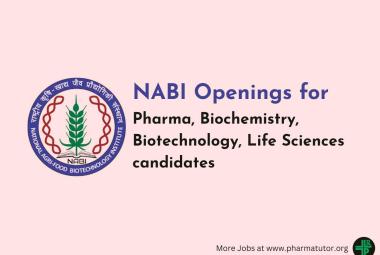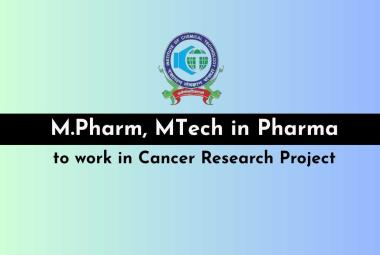ABOUT AUTHORS:
Anjali Gulia*, Saroj Jain
Hindu College Of Pharmacy,
Sonepat
*anjalipharma7@gmail.com
INTRODUCTION:
Delivery of drugs to the brain is a major challenge due to the presence of two physiological dynamic barriers that restricts the delivery of drugs to the CNS, the blood-brain barrier (BBB) and the blood-cerebrospinal fluid barrier (BCSFB) Most attractive area of research in drug delivery, now a-days, is the design of nanocarriers, which are able to deliver drugs to the right place, at appropriate times, and at right dosage. In the era of controlled and site specific drug delivery systems, use of nanocarriers has became a revolutionary approach. Nanocarriers are at fore front of the rapidly developing field of nanotechnology with several potential applications in drug delivery, clinical medicines and research. The success of nanocarriers as targeted drug delivery platforms depends on their ability to incorporate drugs of different kinds, penetrate through several anatomical barriers, sustained release of incorporated drugs, and stability in nanoscale size. Such prototypic traits of nanocarriers offer anew break through in drug delivery and therapeutics that holds great promise for achieving the goal of controlled and site-specific drug delivery. Delivery of drugs to the brain is a major challenge due to presence of physiological barriers that restricts the delivery of drugs to CNS. Thus, since last few decades, nasal route has been attracted a wide attention of researchers as a convenient, reliable, and safe, being non-invasive, route to achieve faster and higher levels of drug absorption in the brain. It is thought to do so through olfactory route of drug transport which bypass the blood-brain barrier (BBB) and allow the direct transport of drug from nose to brain.
REFERENCE ID: PHARMATUTOR-ART-1944
POLYMERIC NANOPARTICLES:
Polymeric nanoparticles based on biodegradable polymers have been extensively studied as they offer improvement in nose-to-brain drug delivery by protecting the encapsulated drug from biological and/or chemical degradation and extra cellular transport by P-gp efflux system. This increases the CNS availability of drugs.eg. polyglycolic acid(PEG), poly lactic acid(PLA), PLGA etc. PLGA nanoparticles loaded with olanzapine for the treatment of psychotic illness, schizophrenia, via nose to brain drug delivery system.
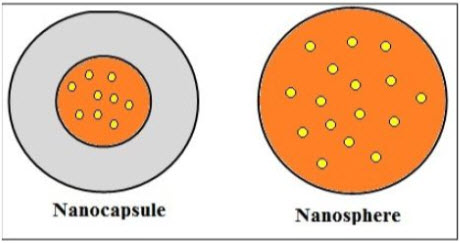
AQUASOMES:
Aquasomes are three-layered structures (core, coat, and drug) which are self-assembled through non covalent bonds, ionic interactions and van der Waals forces. They consist of a ceramic core whose external surface is noncovalently engineered with carbohydrates to obtain a sugar ball, which is then rendered to adsorption of a therapeutic agent. Aquasomes offers an exciting mode of delivering therapeutic agents belonging to the class of proteins and peptides, since they are able to rectify some inherent problems associated with these molecules. These relevant problems include suitable route of drug delivery, physical and chemical instability, poor bioavailability and potent side effects. Aquasomes are not yet explored for nose-to-brain drug delivery of bioactives, but their potential application in delivering proteins and peptides could be exploited for targeting various potent molecules to the CNS.
CUBOSOMES:
Cubosomes (cubs) are discrete, submicron, nano structured particles of bicontinuous cubic liquid crystalline phase. The formulation of targeting ligand (odorranalectin) conjugated Cubosomes loaded with S14G-HN (human in derivative) is found to be useful for the treatment of memory impairments caused by Alzheimer’s disease in rats, as nose-to-brain drug delivery vehicles.
POLYMERIC MICELLES:
Advances in the syntheses of block copolymers have led to the formation of polymeric micelles that may serve as nanoscopic drug carriers. They are known as self-assemblies of block copolymers, and promising nanocarriers for drug and gene delivery. The hydrophilic shell forming copolymers includes:poly(ethylene oxide) (PEG), poly(N-vinyl-2-pyrrolidone) (PVP), poly[N-(2-hydroxypropyl)-methacrylamide] (pHPMA), poly(aspartic acid)(P-Asp), and so on. The lipophilic core forming copolymers includes: poly(propylene oxide)
(PPO), poly(lactic acid) (PLA), poly(amino acid)(PAA), poly(lactide-co-glycolic acid) (PLGA),poly(ε-caprolactone) (PCL).Jain et al., (2010) have reported the formulation and evaluation of micellar nanocarriers for nose to brain delivery of zolmitriptan to treat migraine headache. Their results suggested the potential of micellar carrier as safe, stable and effective new generation vehicle for brain targeting.
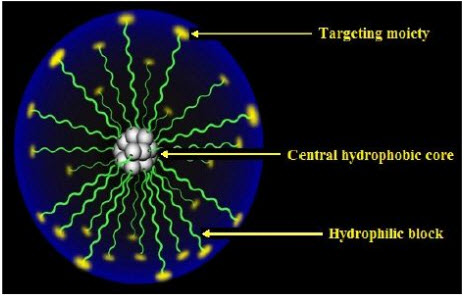
NANOEMULSIONS:
Emulsions with droplet size in the nanometric scale (typically in the range of 20-200 nm) are often referred as mini emulsions, nanoemulsions, ultrafine emulsions, or multiple emulsions, etc. These nanoemulsions appear transparent or translucent to the naked eyes, and possess stability against sedimentation or creaming. Kumar et al. (2008) proposed the intranasal nanoemulsions loaded with risperidone, as drug carriers for brain targeted drug delivery system. Their study demonstrated rapid and larger extent of transport of risperidone into the rat brain.
NANOGELS:
The submicron sized hydrogel particles that are confined to nanoscale dimensions are known as Nanogels. They have high water content, biocompatibility and tunable size from submicrons to tens of nanometers, and an interior for incorporation of therapeutic agents.
These unique characteristics offer great potential for the utilization of nanogels for application in tissue engineering, biomedical implants, bionanotechnology, and drug delivery. Effective polysaccharide-based nanogels can be prepared by using various synthetic strategies, mainly based on chemical and physical cross linking methods, like heterogenenous polymerization, continuous extrusion, precipitation in water, micromolding micro fluidic preparation, spray drying, supramolecular self-assembly, and self complexation. Nanogels have been utilized as potential carriers for oligonucleotide delivery to the brain by using polarized monolayers of bovine BMEC (Brain Microvessel Endothelial Cells), which forms the Blood-Brain Barrier (BBB).
CARBON NANOTUBES (CNTS):
Carbon nanotubes consist exclusively of carbonatoms arranged in a series of condensed benzenerings, which are rolled up into a tubular structure. CNTs can be classified, on the basis oftheir structure, into two types: single-walled carbon nanotubes (SWCNTs) and multi-walled carbon nanotubes (MWCNTs). CNTs can also be explored for nose to brain targeted drug delivery by considering surface engineering approach so as to enhance the bioavailability and therapeutic efficacy of therapeutic agents that otherwise finds difficulty for delivery by any other route.
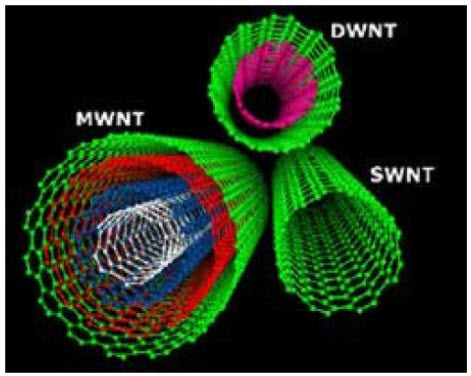
DENDRIMERS:
Dendrimers are a unique class of macromolecules having highly branched, three dimensional, nanoscale architectures with high surface functionality and low polydispersity. Dendron is a segment of the dendrimers. Thus, dendrimers are composed of three distinct regions; as shown in Fig:
i. An initial core.
ii. A series of inner micro domains or internal cavities made up of repetitive molecular units, and
iii. Terminal moieties from which further branching and surface modification can be per formed to enhance the characteristics of native dendrimers.
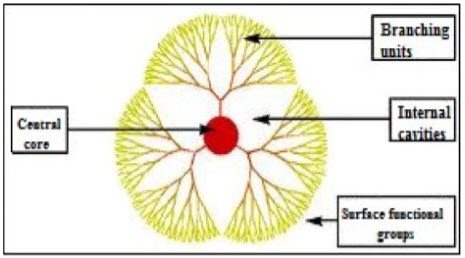
LIPOSOMES:
Liposomes are lyotropic liquid crystals composed of relatively biocompatible and biodegradable materials and consist of an aqueous core entrapped by one or more bilayers of natural and/or synthetic lipids. Lymphatic uptake of liposomes of various sizes, lipid compositions and surface characteristics has been investigated, which in turn suggests the feasibility of liposomes in brain targeting through nasal drug delivery platform.
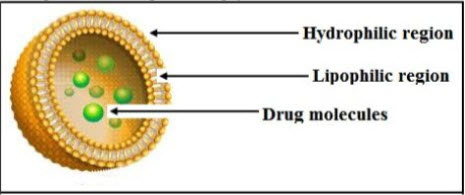
CONCLUSION:
Intranasal administration offers a non-invasive and convenient drug delivery system alternative to conventional drug delivery system of neurotherapeutics to the CNS, effectively bypassing the blood brain barrier (BBB) and more cost-effective protocols with improved patient compliance and minimizing systemic exposure. This review will embark the mechanism of nanoparticles from nose to the CNS or how the nanoparticles carrying the drug are transported or which pathway it follows via the olfactory system or the trigeminal nerves into the CNS where the drug is released. The pathway followed by nanoparticles during administration of neurotherapeutics to the CNS can be influenced by experimental factors such as head,position, volume, and devices used for administration, and formulation parameters, such aspH, osmolarity, viscosity and permeation enhancers (mucoadhesive agent) and drug related factors like lipophilicity, pKa, solubility & dissolution rate.. Thus, this review will provide the relative success of intranasal delivery system for brain targeting.
REFERENCES:
[1] Vyas SP, Khar RK. Molecular basis oftargeted drug delivery. In: SK Jain and VKJain. Targeted and controlled drug delivery: Novel carrier systems, 1st Ed. New Delhi: CBS publishers and distributors; 2011. 38-80.
[2] Kaur IP, Bhandari R, Bhandari S, Kakkar V.Potential of solid lipid nanoparticles inbrain targeting. J Control Release.2008;(127):97-109.
[3] Alam MI, Beg S, Samad A, Baboota S, KohliK, Ali J, Ahuja A, Akbar M. Strategy for effective brain drug delivery. Eur J PharmSci. 2010; (40):385-403.
NOW YOU CAN ALSO PUBLISH YOUR ARTICLE ONLINE.
SUBMIT YOUR ARTICLE/PROJECT AT articles@pharmatutor.org
FIND OUT MORE ARTICLES AT OUR DATABASE







